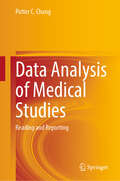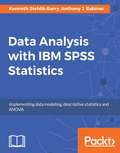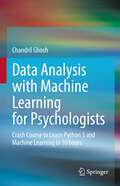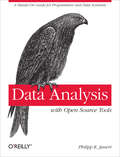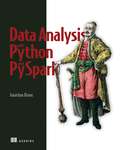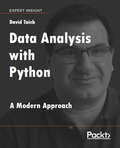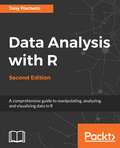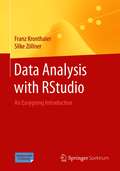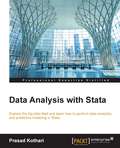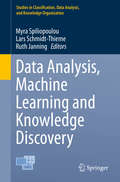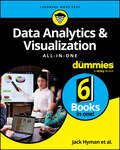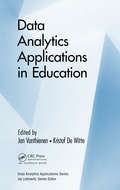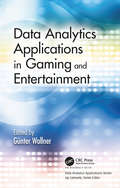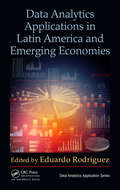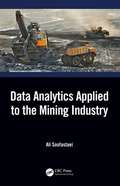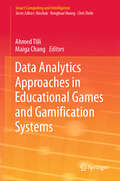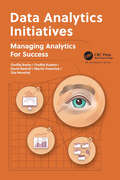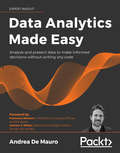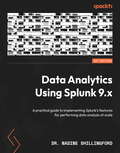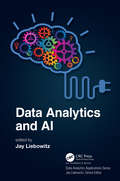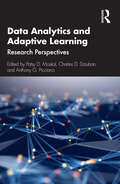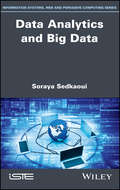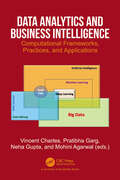- Table View
- List View
Data Analysis of Medical Studies: Reading and Reporting
by Potter C. ChangThis book is written for the many health professionals who are regularly frustrated by elegant but ambiguous descriptions of results of data analysis. It uses articles of the New England Journal of Medicine to demonstrate how ambiguous descriptions of results of data analysis may be read, so that it is clear what they do and do not reveal. These demonstrations also show how statistics is misused.
Data Analysis with IBM SPSS Statistics
by Kenneth Stehlik-Barry Anthony J. BabinecMaster data management & analysis techniques with IBM SPSS Statistics 24 About This Book • Leverage the power of IBM SPSS Statistics to perform efficient statistical analysis of your data • Choose the right statistical technique to analyze different types of data and build efficient models from your data with ease • Overcome any hurdle that you might come across while learning the different SPSS Statistics concepts with clear instructions, tips and tricks Who This Book Is For This book is designed for analysts and researchers who need to work with data to discover meaningful patterns but do not have the time (or inclination) to become programmers. We assume a foundational understanding of statistics such as one would learn in a basic course or two on statistical techniques and methods. What You Will Learn • Install and set up SPSS to create a working environment for analytics • Techniques for exploring data visually and statistically, assessing data quality and addressing issues related to missing data • How to import different kinds of data and work with it • Organize data for analytical purposes (create new data elements, sampling, weighting, subsetting, and restructure your data) • Discover basic relationships among data elements (bivariate data patterns, differences in means, correlations) • Explore multivariate relationships • Leverage the offerings to draw accurate insights from your research, and benefit your decision-making In Detail SPSS Statistics is a software package used for logical batched and non-batched statistical analysis. Analytical tools such as SPSS can readily provide even a novice user with an overwhelming amount of information and a broad range of options for analyzing patterns in the data. The journey starts with installing and configuring SPSS Statistics for first use and exploring the data to understand its potential (as well as its limitations). Use the right statistical analysis technique such as regression, classification and more, and analyze your data in the best possible manner. Work with graphs and charts to visualize your findings. With this information in hand, the discovery of patterns within the data can be undertaken. Finally, the high level objective of developing predictive models that can be applied to other situations will be addressed. By the end of this book, you will have a firm understanding of the various statistical analysis techniques offered by SPSS Statistics, and be able to master its use for data analysis with ease. Style and approach Provides a practical orientation to understanding a set of data and examining the key relationships among the data elements. Shows useful visualizations to enhance understanding and interpretation. Outlines a roadmap that focuses the process so decision regarding how to proceed can be made easily.
Data Analysis with LLMs
by Immanuel TrummerSpeed up common data science tasks with AI assistants like ChatGPT and Large Language Models (LLMs) from Anthropic, Cohere, Open AI, Google, Hugging Face, and more!Data Analysis with LLMs teaches you to use the new generation of AI assistants and Large Language Models (LLMs) to aid and accelerate common data science tasks. Learn how to use LLMs to: • Analyze text, tables, images, and audio files • Extract information from multi-modal data lakes • Classify, cluster, transform, and query multimodal data • Build natural language query interfaces over structured data sources • Use LangChain to build complex data analysis pipelines • Prompt engineering and model configuration All practical, Data Analysis with LLMs takes you from your first prompts through advanced techniques like creating LLM-based agents for data analysis and fine-tuning existing models. You&’ll learn how to extract data, build natural language query interfaces, and much more. About the technology Large Language Models (LLMs) can streamline and accelerate almost any data science task. Master the techniques in this book, and you&’ll be able to analyze large amounts of text, tabular and graph data, images, videos, and more with clear natural language prompts and a few lines of Python code. About the book Data Analysis with LLMs shows you exactly how to integrate generative AI into your day-to-day work as a data scientist. In it, Cornell professor Immanuel Trummer guides you through a series of engaging projects that introduce OpenAI&’s Python library, tools like LangChain and LlamaIndex, and LLMs from Anthropic, Cohere, and Hugging Face. As you go, you&’ll use AI to query structured and unstructured data, analyze sound and images, and optimize the cost and quality of your data analysis process. What's inside • Classify, cluster, transform, and query multimodal data • Build natural language query interfaces over structured data sources • Create LLM-based agents for autonomous data analysis • Prompt engineering and model configuration About the reader For data scientists and data analysts who know the basics of Python. About the author Immanuel Trummer is an associate professor of computer science at Cornell University and a member of the Cornell Database Group. Table of Contents Part 1 1 Analyzing data with large language models 2 Chatting with ChatGPT Part 2 3 The OpenAI Python library 4 Analyzing text data 5 Analyzing structured data 6 Analyzing images and videos 7 Analyzing audio data Part 3 8 GPT alternatives 9 Optimizing cost and quality 10 Software frameworks
Data Analysis with Machine Learning for Psychologists: Crash Course to Learn Python 3 and Machine Learning in 10 hours
by Chandril GhoshThe power of data drives the digital economy of the 21st century. It has been argued that data is as vital a resource as oil was during the industrial revolution. An upward trend in the number of research publications using machine learning in some of the top journals in combination with an increasing number of academic recruiters within psychology asking for Python knowledge from applicants indicates a growing demand for these skills in the market. While there are plenty of books covering data science, rarely, if ever, books in the market address the need of social science students with no computer science background. They are typically written by engineers or computer scientists for people of their discipline. As a result, often such books are filled with technical jargon and examples irrelevant to psychological studies or projects. In contrast, this book was written by a psychologist in a simple, easy-to-understand way that is brief and accessible. The aim for this book was to make the learning experience on this topic as smooth as possible for psychology students/researchers with no background in programming or data science. Completing this book will also open up an enormous amount of possibilities for quantitative researchers in psychological science, as it will enable them to explore newer types of research questions.
Data Analysis with Open Source Tools: A Hands-On Guide for Programmers and Data Scientists
by Philipp K. JanertCollecting data is relatively easy, but turning raw information into something useful requires that you know how to extract precisely what you need. With this insightful book, intermediate to experienced programmers interested in data analysis will learn techniques for working with data in a business environment. You'll learn how to look at data to discover what it contains, how to capture those ideas in conceptual models, and then feed your understanding back into the organization through business plans, metrics dashboards, and other applications.Along the way, you'll experiment with concepts through hands-on workshops at the end of each chapter. Above all, you'll learn how to think about the results you want to achieve -- rather than rely on tools to think for you.Use graphics to describe data with one, two, or dozens of variablesDevelop conceptual models using back-of-the-envelope calculations, as well asscaling and probability argumentsMine data with computationally intensive methods such as simulation and clusteringMake your conclusions understandable through reports, dashboards, and other metrics programsUnderstand financial calculations, including the time-value of moneyUse dimensionality reduction techniques or predictive analytics to conquer challenging data analysis situationsBecome familiar with different open source programming environments for data analysis"Finally, a concise reference for understanding how to conquer piles of data."--Austin King, Senior Web Developer, Mozilla"An indispensable text for aspiring data scientists."--Michael E. Driscoll, CEO/Founder, Dataspora
Data Analysis with Python and PySpark
by Jonathan RiouxThink big about your data! PySpark brings the powerful Spark big data processing engine to the Python ecosystem, letting you seamlessly scale up your data tasks and create lightning-fast pipelines.In Data Analysis with Python and PySpark you will learn how to: Manage your data as it scales across multiple machines Scale up your data programs with full confidence Read and write data to and from a variety of sources and formats Deal with messy data with PySpark&’s data manipulation functionality Discover new data sets and perform exploratory data analysis Build automated data pipelines that transform, summarize, and get insights from data Troubleshoot common PySpark errors Creating reliable long-running jobs Data Analysis with Python and PySpark is your guide to delivering successful Python-driven data projects. Packed with relevant examples and essential techniques, this practical book teaches you to build pipelines for reporting, machine learning, and other data-centric tasks. Quick exercises in every chapter help you practice what you&’ve learned, and rapidly start implementing PySpark into your data systems. No previous knowledge of Spark is required. About the technology The Spark data processing engine is an amazing analytics factory: raw data comes in, insight comes out. PySpark wraps Spark&’s core engine with a Python-based API. It helps simplify Spark&’s steep learning curve and makes this powerful tool available to anyone working in the Python data ecosystem. About the book Data Analysis with Python and PySpark helps you solve the daily challenges of data science with PySpark. You&’ll learn how to scale your processing capabilities across multiple machines while ingesting data from any source—whether that&’s Hadoop clusters, cloud data storage, or local data files. Once you&’ve covered the fundamentals, you&’ll explore the full versatility of PySpark by building machine learning pipelines, and blending Python, pandas, and PySpark code. What's inside Organizing your PySpark code Managing your data, no matter the size Scale up your data programs with full confidence Troubleshooting common data pipeline problems Creating reliable long-running jobs About the reader Written for data scientists and data engineers comfortable with Python. About the author As a ML director for a data-driven software company, Jonathan Rioux uses PySpark daily. He teaches the software to data scientists, engineers, and data-savvy business analysts. Table of Contents 1 Introduction PART 1 GET ACQUAINTED: FIRST STEPS IN PYSPARK 2 Your first data program in PySpark 3 Submitting and scaling your first PySpark program 4 Analyzing tabular data with pyspark.sql 5 Data frame gymnastics: Joining and grouping PART 2 GET PROFICIENT: TRANSLATE YOUR IDEAS INTO CODE 6 Multidimensional data frames: Using PySpark with JSON data 7 Bilingual PySpark: Blending Python and SQL code 8 Extending PySpark with Python: RDD and UDFs 9 Big data is just a lot of small data: Using pandas UDFs 10 Your data under a different lens: Window functions 11 Faster PySpark: Understanding Spark&’s query planning PART 3 GET CONFIDENT: USING MACHINE LEARNING WITH PYSPARK 12 Setting the stage: Preparing features for machine learning 13 Robust machine learning with ML Pipelines 14 Building custom ML transformers and estimators
Data Analysis with Python: A Modern Approach
by David TaiebLearn a modern approach to data analysis using Python to harness the power of programming and AI across your data. Detailed case studies bring this modern approach to life across visual data, social media, graph algorithms, and time series analysis. Key Features Bridge your data analysis with the power of programming, complex algorithms, and AI Use Python and its extensive libraries to power your way to new levels of data insight Work with AI algorithms, TensorFlow, graph algorithms, NLP, and financial time series Explore this modern approach across with key industry case studies and hands-on projects Book Description Data Analysis with Python offers a modern approach to data analysis so that you can work with the latest and most powerful Python tools, AI techniques, and open source libraries. Industry expert David Taieb shows you how to bridge data science with the power of programming and algorithms in Python. You'll be working with complex algorithms, and cutting-edge AI in your data analysis. Learn how to analyze data with hands-on examples using Python-based tools and Jupyter Notebook. You'll find the right balance of theory and practice, with extensive code files that you can integrate right into your own data projects. Explore the power of this approach to data analysis by then working with it across key industry case studies. Four fascinating and full projects connect you to the most critical data analysis challenges you're likely to meet in today. The first of these is an image recognition application with TensorFlow – embracing the importance today of AI in your data analysis. The second industry project analyses social media trends, exploring big data issues and AI approaches to natural language processing. The third case study is a financial portfolio analysis application that engages you with time series analysis - pivotal to many data science applications today. The fourth industry use case dives you into graph algorithms and the power of programming in modern data science. You'll wrap up with a thoughtful look at the future of data science and how it will harness the power of algorithms and artificial intelligence. What you will learn A new toolset that has been carefully crafted to meet for your data analysis challenges Full and detailed case studies of the toolset across several of today's key industry contexts Become super productive with a new toolset across Python and Jupyter Notebook Look into the future of data science and which directions to develop your skills next Who this book is for This book is for developers wanting to bridge the gap between them and data scientists. Introducing PixieDust from its creator, the book is a great desk companion for the accomplished Data Scientist. Some fluency in data interpretation and visualization is assumed. It will be helpful to have some knowledge of Python, using Python libraries, and some proficiency in web development.
Data Analysis with R, Second Edition: A Comprehensive Guide To Manipulating, Analyzing, And Visualizing Data In R, 2nd Edition
by Tony FischettiR has spread deep into the private sector and can be found in the production pipelines at some of the most advanced and successful enterprises. Starting with the basics of R and statistical reasoning, this book dives into advanced predictive analytics, showing how to apply those techniques to real-world data though with real-world examples.
Data Analysis with R, Second Edition: A comprehensive guide to manipulating, analyzing, and visualizing data in R, 2nd Edition
by Anthony FischettiLearn, by example, the fundamentals of data analysis as well as several intermediate to advanced methods and techniques ranging from classification and regression to Bayesian methods and MCMC, which can be put to immediate use. Key FeaturesAnalyze your data using R – the most powerful statistical programming languageLearn how to implement applied statistics using practical use-casesUse popular R packages to work with unstructured and structured dataBook DescriptionFrequently the tool of choice for academics, R has spread deep into the private sector and can be found in the production pipelines at some of the most advanced and successful enterprises. The power and domain-specificity of R allows the user to express complex analytics easily, quickly, and succinctly. Starting with the basics of R and statistical reasoning, this book dives into advanced predictive analytics, showing how to apply those techniques to real-world data though with real-world examples.Packed with engaging problems and exercises, this book begins with a review of R and its syntax with packages like Rcpp, ggplot2, and dplyr. From there, get to grips with the fundamentals of applied statistics and build on this knowledge to perform sophisticated and powerful analytics. Solve the difficulties relating to performing data analysis in practice and find solutions to working with messy data, large data, communicating results, and facilitating reproducibility.This book is engineered to be an invaluable resource through many stages of anyone’s career as a data analyst.What you will learn Gain a thorough understanding of statistical reasoning and sampling theory Employ hypothesis testing to draw inferences from your data Learn Bayesian methods for estimating parameters Train regression, classification, and time series models Handle missing data gracefully using multiple imputation Identify and manage problematic data points Learn how to scale your analyses to larger data with Rcpp, data.table, dplyr, and parallelization Put best practices into effect to make your job easier and facilitate reproducibilityWho this book is forBudding data scientists and data analysts who are new to the concept of data analysis, or who want to build efficient analytical models in R will find this book to be useful. No prior exposure to data analysis is needed, although a fundamental understanding of the R programming language is required to get the best out of this book.
Data Analysis with RStudio: An Easygoing Introduction
by Franz Kronthaler Silke ZöllnerThe objective of this text is to introduce RStudio to practitioners and students and enable them to use R in their everyday work. It is not a statistical textbook, the purpose is to transmit the joy of analyzing data with RStudio. Practitioners and students learn how RStudio can be installed and used, they learn to import data, write scripts and save working results. Furthermore, they learn to employ descriptive statistics and create graphics with RStudio. Additionally, it is shown how RStudio can be used to test hypotheses, run an analysis of variance and regressions. To deepen the learned content, tasks are included with the solutions provided at the end of the textbook. This textbook has been recommended and developed for university courses in Germany, Austria and Switzerland.
Data Analysis with STATA
by Prasad KothariThis book is for all the professionals and students who want to learn STATA programming and apply predictive modelling concepts. This book is also very helpful for experienced STATA programmers as it provides advanced statistical modelling concepts and their application.
Data Analysis, Machine Learning and Knowledge Discovery (Studies in Classification, Data Analysis, and Knowledge Organization)
by Myra Spiliopoulou Lars Schmidt-Thieme Ruth JanningData analysis, machine learning and knowledge discovery are research areas at the intersection of computer science, artificial intelligence, mathematics and statistics. They cover general methods and techniques that can be applied to a vast set of applications such as web and text mining, marketing, medicine, bioinformatics and business intelligence. This volume contains the revised versions of selected papers in the field of data analysis, machine learning and knowledge discovery presented during the 36th annual conference of the German Classification Society (GfKl). The conference was held at the University of Hildesheim (Germany) in August 2012.
Data Analytics & Visualization All-in-One For Dummies
by John Paul Mueller Joseph Schmuller Allen G. Taylor Alan R. Simon Lillian Pierson Luca Massaron Paul McFedries Jack A. Hyman Jonathan ReichentalInstall data analytics into your brain with this comprehensive introduction Data Analytics & Visualization All-in-One For Dummies collects the essential information on mining, organizing, and communicating data, all in one place. Clocking in at around 850 pages, this tome of a reference delivers eight books in one, so you can build a solid foundation of knowledge in data wrangling. Data analytics professionals are highly sought after these days, and this book will put you on the path to becoming one. You’ll learn all about sources of data like data lakes, and you’ll discover how to extract data using tools like Microsoft Power BI, organize the data in Microsoft Excel, and visually present the data in a way that makes sense using a Tableau. You’ll even get an intro to the Python, R, and SQL coding needed to take your data skills to a new level. With this Dummies guide, you’ll be well on your way to becoming a priceless data jockey. Mine data from data sources Organize and analyze data Use data to tell a story with Tableau Expand your know-how with Python and R New and novice data analysts will love this All-in-One reference on how to make sense of data. Get ready to watch as your career in data takes off.
Data Analytics Applications in Education (Data Analytics Applications)
by Jan Vanthienen Kristof De WitteThe abundance of data and the rise of new quantitative and statistical techniques have created a promising area: data analytics. This combination of a culture of data-driven decision making and techniques to include domain knowledge allows organizations to exploit big data analytics in their evaluation and decision processes. Also, in education and learning, big data analytics is being used to enhance the learning process, to evaluate efficiency, to improve feedback, and to enrich the learning experience. As every step a student takes in the online world can be traced, analyzed, and used, there are plenty of opportunities to improve the learning process of students. First, data analytics techniques can be used to enhance the student’ s learning process by providing real-time feedback, or by enriching the learning experience. Second, data analytics can be used to support the instructor or teacher. Using data analytics, the instructor can better trace, and take targeted actions to improve, the learning process of the student. Third, there are possibilities in using data analytics to measure the performance of instructors. Finally, for policy makers, it is often unclear how schools use their available resources to "produce" outcomes. By combining structured and unstructured data from various sources, data analytics might provide a solution for governments that aim to monitor the performance of schools more closely. Data analytics in education should not be the domain of a single discipline. Economists should discuss the possibilities, issues, and normative questions with a multidisciplinary team of pedagogists, philosophers, computer scientists, and sociologists. By bringing together various disciplines, a more comprehensive answer can be formulated to the challenges ahead. This book starts this discussion by highlighting some economic perspectives on the use of data analytics in education. The book begins a rich, multidisciplinary discussion that may make data analytics in education seem as natural as a teacher in front of a classroom.
Data Analytics Applications in Gaming and Entertainment (Data Analytics Applications)
by Günter WallnerThe last decade has witnessed the rise of big data in game development as the increasing proliferation of Internet-enabled gaming devices has made it easier than ever before to collect large amounts of player-related data. At the same time, the emergence of new business models and the diversification of the player base have exposed a broader potential audience, which attaches great importance to being able to tailor game experiences to a wide range of preferences and skill levels. This, in turn, has led to a growing interest in data mining techniques, as they offer new opportunities for deriving actionable insights to inform game design, to ensure customer satisfaction, to maximize revenues, and to drive technical innovation. By now, data mining and analytics have become vital components of game development. The amount of work being done in this area nowadays makes this an ideal time to put together a book on this subject. Data Analytics Applications in Gaming and Entertainment seeks to provide a cross section of current data analytics applications in game production. It is intended as a companion for practitioners, academic researchers, and students seeking knowledge on the latest practices in game data mining. The chapters have been chosen in such a way as to cover a wide range of topics and to provide readers with a glimpse at the variety of applications of data mining in gaming. A total of 25 authors from industry and academia have contributed 12 chapters covering topics such as player profiling, approaches for analyzing player communities and their social structures, matchmaking, churn prediction and customer lifetime value estimation, communication of analytical results, and visual approaches to game analytics. This book’s perspectives and concepts will spark heightened interest in game analytics and foment innovative ideas that will advance the exciting field of online gaming and entertainment.
Data Analytics Applications in Latin America and Emerging Economies (Data Analytics Applications)
by Eduardo RodriguezThis book focuses on understanding the analytics knowledge management process and its comprehensive application to various socioeconomic sectors. Using cases from Latin America and other emerging economies, it examines analytics knowledge applications where a solution has been achieved. Written for business students and professionals as well as researchers, the book is filled with practical insight into applying concepts and implementing processes and solutions. The eleven case studies presented in the book incorporate the whole analytics process and are useful reference examples for applying the analytics process for SME organizations in both developing and developed economies. The cases also identify multiple tacit factors to deal with during the implementation of analytics knowledge management processes. These factors, which include data cleaning, data gathering, and interpretation of results, are not always easily identified by analytics practitioners. This book promotes the understanding of analytics methods and techniques. It guides readers through numerous techniques and methods available to analytics practitioners by explaining the strengths and weaknesses of these methods and techniques.
Data Analytics Applied to the Mining Industry
by Ali SoofastaeiData Analytics Applied to the Mining Industry describes the key challenges facing the mining sector as it transforms into a digital industry able to fully exploit process automation, remote operation centers, autonomous equipment and the opportunities offered by the industrial internet of things. It provides guidelines on how data needs to be collected, stored and managed to enable the different advanced data analytics methods to be applied effectively in practice, through use of case studies, and worked examples. Aimed at graduate students, researchers, and professionals in the industry of mining engineering, this book: Explains how to implement advanced data analytics through case studies and examples in mining engineering Provides approaches and methods to improve data-driven decision making Explains a concise overview of the state of the art for Mining Executives and Managers Highlights and describes critical opportunity areas for mining optimization Brings experience and learning in digital transformation from adjacent sectors
Data Analytics Approaches in Educational Games and Gamification Systems (Smart Computing and Intelligence)
by Maiga Chang Ahmed TliliGame-based learning environments and learning analytics are attracting increasing attention from researchers and educators, since they both can enhance learning outcomes. This book focuses on the application of data analytics approaches and research on human behaviour analysis in game-based learning environments, namely educational games and gamification systems, to provide smart learning. Specifically, it discusses the purposes, advantages and limitations of applying such approaches in these environments. Additionally, the various smart game-based learning environments presented help readers integrate learning analytics in their educational games and gamification systems to, for instance, assess and model students (e.g. their computational thinking) or enhance the learning process for better outcomes. Moreover, the book presents general guidelines on various aspects, such as collecting data for analysis, game-based learning environment design, system architecture and applied algorithms, which facilitate incorporating learning analytics into educational games and gamification systems.After a general introduction to help readers become familiar with the subject area, the individual chapters each discuss a different aim of applying data analytics approaches in educational games and gamification systems. Lastly, the conclusion provides a summary and presents general guidelines and frameworks to consider when designing smart game-based learning environments with learning analytics.
Data Analytics Initiatives: Managing Analytics for Success
by Ondřej Bothe Ondřej Kubera David Bednář Martin Potančok Ota NovotnýThe categorisation of analytical projects could help to simplify complexity reasonably and, at the same time, clarify the critical aspects of analytical initiatives. But how can this complex work be categorized? What makes it so complex? Data Analytics Initiatives: Managing Analytics for Success emphasizes that each analytics project is different. At the same time, analytics projects have many common aspects, and these features make them unique compared to other projects. Describing these commonalities helps to develop a conceptual understanding of analytical work. However, features specific to each initiative affects the entire analytics project lifecycle. Neglecting them by trying to use general approaches without tailoring them to each project can lead to failure. In addition to examining typical characteristics of the analytics project and how to categorise them, the book looks at specific types of projects, provides a high-level assessment of their characteristics from a risk perspective, and comments on the most common problems or challenges. The book also presents examples of questions that could be asked of relevant people to analyse an analytics project. These questions help to position properly the project and to find commonalities and general project challenges.
Data Analytics Made Easy: Use machine learning and data storytelling in your work without writing any code
by Andrea De Mauro Francesco Marzoni Andrew J. WalterMake informed decisions using data analytics, machine learning, and data visualizationsKey FeaturesTake raw data and transform it to add value to your organizationLearn the art of telling stories with your data to engage with your audienceApply machine learning algorithms to your data with a few clicks of a buttonBook DescriptionData analytics has become a necessity in modern business, and skills such as data visualization, machine learning, and digital storytelling are now essential in every field. If you want to make sense of your data and add value with informed decisions, this is the book for you. Data Analytics Made Easy is an accessible guide to help you start analyzing data and quickly apply these skills to your work. It focuses on how to generate insights from your data at the click of a few buttons, using the popular tools KNIME and Microsoft Power BI. The book introduces the concepts of data analytics and shows you how to get your data ready and apply machine learning algorithms. Implement a complete predictive analytics solution with KNIME and assess its level of accuracy. Create impressive visualizations with Microsoft Power BI and learn the greatest secret in successful analytics – how to tell a story with your data. You'll connect the dots on the various stages of the data-to-insights process and gain an overview of alternative tools, including Tableau and H20 Driverless AI. By the end of this book, you will have learned how to implement machine learning algorithms and sell the results to your customers without writing a line of code.What you will learnUnderstand the potential of data and its impact on any businessInfluence business decisions with effective data storytelling when delivering insightsUse KNIME to import, clean, transform, combine data feeds, and automate recurring workflowsLearn the basics of machine learning and AutoML to add value to your organizationBuild, test, and validate simple supervised and unsupervised machine learning models with KNIMEUse Power BI and Tableau to build professional-looking and business-centric visuals and dashboardsWho this book is forWhether you are working with data experts or want to find insights in your business' data, you'll find this book an effective way to add analytics to your skill stack.No previous math, statistics, or computer science knowledge is required.
Data Analytics Using Splunk 9.x: A practical guide to implementing Splunk's features for performing data analysis at scale
by Dr. Nadine ShillingfordMake the most of Splunk 9.x to build insightful reports and dashboards with a detailed walk-through of its extensive features and capabilitiesKey FeaturesBe well-versed with the Splunk 9. x architecture, installation, onboarding, and indexing data featuresCreate advanced visualizations using the Splunk search processing languageExplore advanced Splunk administration techniques, including clustering, data modeling, and container managementBook DescriptionSplunk 9 improves on the existing Splunk tool to include important features such as federated search, observability, performance improvements, and dashboarding. This book helps you to make the best use of the impressive and new features to prepare a Splunk installation that can be employed in the data analysis process.Starting with an introduction to the different Splunk components, such as indexers, search heads, and forwarders, this Splunk book takes you through the step-by-step installation and configuration instructions for basic Splunk components using Amazon Web Services (AWS) instances. You'll import the BOTS v1 dataset into a search head and begin exploring data using the Splunk Search Processing Language (SPL), covering various types of Splunk commands, lookups, and macros. After that, you'll create tables, charts, and dashboards using Splunk's new Dashboard Studio, and then advance to work with clustering, container management, data models, federated search, bucket merging, and more.By the end of the book, you'll not only have learned everything about the latest features of Splunk 9 but also have a solid understanding of the performance tuning techniques in the latest version.What you will learnInstall and configure the Splunk 9 environmentCreate advanced dashboards using the flexible layout options in Dashboard StudioUnderstand the Splunk licensing modelsCreate tables and make use of the various types of charts available in Splunk 9.xExplore the new configuration management featuresImplement the performance improvements introduced in Splunk 9.xIntegrate Splunk with Kubernetes for optimizing CI/CD managementWho this book is forThe book is for data analysts, Splunk users, and administrators who want to become well-versed in the data analytics services offered by Splunk 9. You need to have a basic understanding of Splunk fundamentals to get the most out of this book.
Data Analytics and AI (Data Analytics Applications)
by Jay LiebowitzAnalytics and artificial intelligence (AI), what are they good for? The bandwagon keeps answering, absolutely everything! Analytics and artificial intelligence have captured the attention of everyone from top executives to the person in the street. While these disciplines have a relatively long history, within the last ten or so years they have exploded into corporate business and public consciousness. Organizations have rushed to embrace data-driven decision making. Companies everywhere are turning out products boasting that "artificial intelligence is included." We are indeed living in exciting times. The question we need to ask is, do we really know how to get business value from these exciting tools? Unfortunately, both the analytics and AI communities have not done a great job in collaborating and communicating with each other to build the necessary synergies. This book bridges the gap between these two critical fields. The book begins by explaining the commonalities and differences in the fields of data science, artificial intelligence, and autonomy by giving a historical perspective for each of these fields, followed by exploration of common technologies and current trends in each field. The book also readers introduces to applications of deep learning in industry with an overview of deep learning and its key architectures, as well as a survey and discussion of the main applications of deep learning. The book also presents case studies to illustrate applications of AI and analytics. These include a case study from the healthcare industry and an investigation of a digital transformation enabled by AI and analytics transforming a product-oriented company into one delivering solutions and services. The book concludes with a proposed AI-informed data analytics life cycle to be applied to unstructured data.
Data Analytics and Adaptive Learning: Research Perspectives
by Patsy D. Moskal, Charles D. Dziuban, and Anthony G. PiccianoData Analytics and Adaptive Learning offers new insights into the use of emerging data analysis and adaptive techniques in multiple learning settings. In recent years, both analytics and adaptive learning have helped educators become more responsive to learners in virtual, blended, and personalized environments. This set of rich, illuminating, international studies spans quantitative, qualitative, and mixed-methods research in higher education, K–12, and adult/continuing education contexts. By exploring the issues of definition and pedagogical practice that permeate teaching and learning and concluding with recommendations for the future research and practice necessary to support educators at all levels, this book will prepare researchers, developers, and graduate students of instructional technology to produce evidence for the benefits and challenges of data-driven learning.
Data Analytics and Big Data: Understand Data And Take To Analytics Applications And Methods
by Soraya SedkaouiThe main purpose of this book is to investigate, explore and describe approaches and methods to facilitate data understanding through analytics solutions based on its principles, concepts and applications. But analyzing data is also about involving the use of software. For this, and in order to cover some aspect of data analytics, this book uses software (Excel, SPSS, Python, etc) which can help readers to better understand the analytics process in simple terms and supporting useful methods in its application.
Data Analytics and Business Intelligence: Computational Frameworks, Practices, and Applications
by Mohini AgarwalBusiness Analytics (BA) is an evolving phenomenon that showcases the increasing importance of using huge volumes of data to generate value for businesses. Advances in BA have offered great opportunities for organisations to improve, innovate, and develop existing or new processes, products, and services. BA is the process of transforming data into actionable insight by using statistical and mathematical analysis, descriptive, prescriptive, and predictive models, machine learning, information systems and network science methods, among others, along with a variety of data, expert knowledge, and fact-based management to support better and faster decision-making. BA and Business Intelligence (BI) generate capabilities for companies to compete in the market effectively and has become one of the main functional areas in most companies. BA tools are used in diverse ways, for example, to identify consumer behaviour patterns and market trends, to derive valuable insights on the performance of stocks, to find information on the attrition rate of employees, to analyse and solve healthcare problems, to offer insight into inventory management and supply chain management, to analyse data from social networks, and to infer traffic behaviour and develop traffic management policy, among others. BA and BI have become one of the most popular research areas in academic circles, as well as in the industry, driven by the increasing demand in the business world. This book aims to become a stimulus for innovative business solutions covering a wide range of aspects of business analytics, such as management science, information technology, descriptive, prescriptive, and predictive models, machine learning, network science, mathematical and statistical techniques. The book will encompass a valuable collection of chapters exploring and discussing computational frameworks, practices, and applications of BA that can assist industries and relevant stakeholders in decision-making and problem-solving exercises, with a view to driving competitive advantage.
